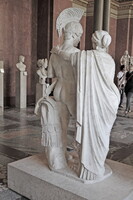| dc.coverage.spatial | Site: Musée du Louvre (Paris, Île-de-France, France) MR 316 (Ma 1009) | en_US |
| dc.coverage.temporal | ca. 120-140 (creation); reworked 170-175 (alteration) | en_US |
| dc.creator | unknown (Ancient Roman) | en_US |
| dc.date | 120-140 | en_US |
| dc.date.accessioned | 2013-12-31T16:15:35Z | |
| dc.date.available | 2013-12-31T16:15:35Z | |
| dc.date.issued | 120-140 | en_US |
| dc.identifier | 245342 | en_US |
| dc.identifier.other | archrefid: 2840 | en_US |
| dc.identifier.uri | http://hdl.handle.net/1721.3/153780 | |
| dc.description | Overall view of figure group from rear, right; This group reproduced the features of the of the Emperor Hadrian and his wife Sabina, until her head was replaced during the late second century by another portrait, probably of Lucilla, wife of Lucius Verus. It reflects the Hellenizing taste and the neoclassical style in fashion during this period. Hadrian (117-138 CE), the first Roman emperor to be portrayed as a god during his own lifetime, is depicted as Mars, god of war. Discovered near Santa Maria Maggiore in Rome just before 1620. Source: Louvre Museum [website]; http://www.louvre.fr/ (accessed 4/29/2013) | en_US |
| dc.format.medium | marble | en_US |
| dc.rights | © Scott Gilchrist, Archivision, Inc. | en_US |
| dc.subject | allegory | en_US |
| dc.subject | mythology (Classical) | en_US |
| dc.subject | rulers and leaders | en_US |
| dc.subject | Hadrian, Emperor of Rome, 76-138. | en_US |
| dc.subject | Roman Empire | en_US |
| dc.subject | propaganda | en_US |
| dc.subject | Imperial (Roman) | en_US |
| dc.title | Imperial group (Hadrian and Sabina) as Mars and Venus | en_US |
| dc.type | image | en_US |
| dc.rights.access | Licensed for educational and research use by the MIT community only | en_US |
| dc.identifier.vendorcode | 7A3-R-L-MV-A02 | en_US |
| vra.culturalContext | Ancient Roman | en_US |
| vra.technique | carving (processes) | en_US |
| vra.worktype | sculpture (visual work) | en_US |
| dc.contributor.display | unknown (Ancient Roman) | en_US |


